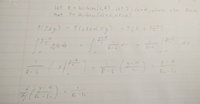Hello everyone, i was wondering if i'm doing the transformation of continuous rv correctly using the cdf method. It looks correct to me but i dont have the variable d like the question tells me to prove.
Let X ∼ Uniform[L, R]. Let Y = cX + d, where c > 0. Prove that Y ∼ Uniform[cL + d, cR + d].
Let X ∼ Uniform[L, R]. Let Y = cX + d, where c > 0. Prove that Y ∼ Uniform[cL + d, cR + d].

